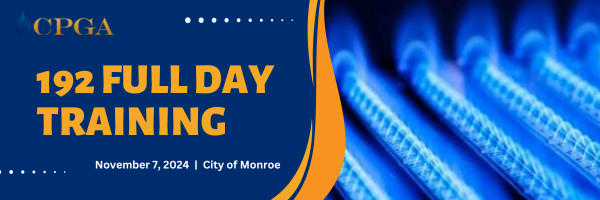November 7, 2024

Join us for the 192 Full Day Training at the City of Monroe on Thursday, November 7, from 8:30 a.m. to 5:00 p.m. The cost is $200 per person and includes lunch. The training will take place at the Old Armory Community Center (500 S. Johnson St., Monroe, NC 28110).
Space is limited so register early.
Training provided by Mike Bradley, EverLine
Key Takeaways:
1. A understanding of how pipeline safety regulations came to exist and how the federal government promulgates and enforces pipeline safety regulations.
2. How everyday work on a jurisdictional pipeline system is governed by and interacts with the regulatory requirements.
3. The framework, rules and expectations that govern our interactions with state and federal regulatory agencies and best practices for constructive regulatory relationships.
Training Objectives
To facilitate the key takeaways described above, EverLine proposes to develop a training program that supports the following specific learning objectives:
1. Impart an understanding of how code is promulgated at the Federal/PHMSA level
a. How incidents drive regulation & a quick review of major industry incidents and the specific sections of code they inspired (code is “written in blood”, this will explain how and why)
b. The roles of the NTSB, PHMSA, GPAC, NAPSR and the OMB in the rulemaking process.(what is the process by which ideas become code)
c. The construct of Federal code: prescriptive vs. performance code styles, micro vs. macrocode styles (this is why different parts of 192-199 read so differently)
d.The elements that comprise “code”, including the code itself, advisory bulletins, FAQs, interpretations, special permits, enforcement guidelines, inspection questions, standards incorporated by reference, GPTC, etc.
2.Discuss the importance of company-specific and trade association interpretations of code and the recording of those interpretations in O&M guidance materials (said another way, the role the O&M manual and various plans play in compliance).
3.Provide a broad overview of how 49 CFR is laid out, including major elements of 190-199 with a guide on learning how to navigate the code. Specific areas will receive a deeper treatment for education and example purposes. This will include a discussion on the interaction between state and federal regulations.
4.Provide an overview of select 49 CFR code sections with an emphasis on what drove their promulgation, the key expectations of operators under those sections, industry common practices, and potential challenges. Overview will include at least the following: Operator Qualification (Subpart N), Drug & Alcohol Misuse (Part 199), 192.605 (OM&E manuals), and Management of Change (MOC as required by 192.13(d) for transmission operators).•Time allowing, a primer on Pipeline Safety Management Systems (PSMS) and API 1173will be included.
5.Impart an understanding of code enforcement, including the organizations that enforce code, civil penalties, appeals, etc. This will include an overview of enforcement guidance, and the rules established in parts 190 and 191.
6.Discuss the relationship between regulators, operators, vendors/consultants, and outside interested parties (e.g. lobbyists, trade associations, interveners and other special interests)
7.Share best practices and anecdotes related to interactions between operator and regulatory personnel that facilitate a productive relationship.
8.Talk about trends in rulemaking, including the recent addition of environmental protection to PHMSA’s scope and what we expect coming down the regulatory pipeline.
9.Open discussion with presenter, Q&A, etc.
